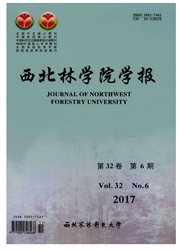

 中文摘要:
中文摘要:
通过调查11~62a不同龄级青海云杉的主要生长指标,对其植被碳密度和碳储量进行估算,并分析其与胸径、树高和林龄等的相关关系,以评估青海省大通县青海云杉林的碳汇功能。结果表明:青海云杉林碳密度为22.06~166.56t·hm-2,平均65.68t·hm-2其中活体碳密度占85.4%,枯落物碳密度占14.6%。植被活体碳密度与胸径和树高呈显著正相关,随林龄的增大先增大后减小,在林龄49a时达到最大,为151.20t·hm-2枯落物碳密度与活体碳密度变化规律基本一致,而枯死率则相反,林龄49a的云杉林枯落物碳密度最大,为15.36t·hm-2枯死率最小,为10%。
 英文摘要:
英文摘要:
This paper surveyed the main growth indicators of Picea crassifolia in different ages from 11 a to 62 a, estimated its vegetation carbon density and storage, analyzed the correlativity among the carbon density, diameter at breast height (DBH), height and age, assessed the carbon sinking function of P. crassifolia in Datong Country of Qinghai Province. The results showed that the vegetation carbon density first increased and then decreased with age in the range of 22.06-166.56 t· hm-2. The average vegetation carbon density was 65.68 t· hm 2, of which the living carbon density accounted for 85.4%, litter carbon density was only 14.6%. The living carbon density was positively correlated with DBH and height, and first increased then decreased with age. The living carbon density reached the biggest 151.20 t · hm 2 at the age 49 a. The variation trend of litter carbon density with age was consistent with the living carbon density, while the death rate exhibited the opposite change. The litter carbon density reached the maxi mum 15.36 t· hm 2 at the age 49 a, but the death rate was in minimum 10%.
 同期刊论文项目
同期刊论文项目
 同项目期刊论文
同项目期刊论文
 期刊信息
期刊信息
